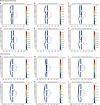Comparison of Hemodynamic Energy between Expanded Polytetrafluoroethylene and Dacron Artificial Vessels
- PMID: 33767024
- PMCID: PMC8038878
- DOI: 10.5090/jcs.20.134
Comparison of Hemodynamic Energy between Expanded Polytetrafluoroethylene and Dacron Artificial Vessels
Abstract
Background: Artificial grafts such as polyethylene terephthalate (Dacron) and expanded polytetrafluoroethylene (ePTFE) are used for various cardiovascular surgical procedures. The compliance properties of prosthetic grafts could affect hemodynamic energy, which can be measured using the energy-equivalent pressure (EEP) and surplus hemodynamic energy (SHE). We investigated changes in the hemodynamic energy of prosthetic grafts.
Methods: In a simulation test, the changes in EEP for these grafts were estimated using COMSOL MULTIPHYSICS. The Young modulus, Poisson ratio, and density were used to analyze the grafts' material properties, and pre- and post-graft EEP values were obtained by computing the product of the pressure and velocity. In an in vivo study, Dacron and ePTFE grafts were anastomosed in an end-to-side fashion on the descending thoracic aorta of swine. The pulsatile pump flow was fixed at 2 L/min. Real-time flow and pressure were measured at the distal part of each graft, while clamping the other graft and the descending thoracic aorta. EEP and SHE were calculated and compared.
Results: In the simulation test, the mean arterial pressure decreased by 39% for all simulations. EEP decreased by 42% for both grafts, and by around 55% for the native blood vessels after grafting. The in vivo test showed no significant difference between both grafts in terms of EEP and SHE.
Conclusion: The post-graft hemodynamic energy was not different between the Dacron and ePTFE grafts. Artificial grafts are less compliant than native blood vessels; however, they can deliver pulsatile blood flow and hemodynamic energy without any significant energy loss.
Keywords: Artificial blood vessles; Energy; Hemodynamics; Pulse.
Conflict of interest statement
No potential conflict of interest relevant to this article was reported.
Figures




Similar articles
-
The effects of vasopressor and vasodilator on hemodynamic energy in terms of surplus hemodynamic energy.ASAIO J. 2008 Sep-Oct;54(5):534-7. doi: 10.1097/MAT.0b013e31818652fc. ASAIO J. 2008. PMID: 18812748
-
The effects of dopamine, ephinephrine, and esmolol on the hemodynamic energy in terms of the energy equivalent pressure.ASAIO J. 2007 Nov-Dec;53(6):791-4. doi: 10.1097/MAT.0b013e318158e930. ASAIO J. 2007. PMID: 18043167
-
The development of endotension is associated with increased transmission of pressure and serous components in porous expanded polytetrafluoroethylene stent-grafts: characterization using a canine model.J Vasc Surg. 2006 Jan;43(1):109-16. doi: 10.1016/j.jvs.2005.09.023. J Vasc Surg. 2006. PMID: 16414397
-
A meta-analysis to compare Dacron versus polytetrafluroethylene grafts for above-knee femoropopliteal artery bypass.J Vasc Surg. 2014 Aug;60(2):506-15. doi: 10.1016/j.jvs.2014.05.049. Epub 2014 Jun 25. J Vasc Surg. 2014. PMID: 24973288 Review.
-
A contemporary meta-analysis of Dacron versus polytetrafluoroethylene grafts for femoropopliteal bypass grafting.J Vasc Surg. 2010 Jul;52(1):232-6. doi: 10.1016/j.jvs.2010.02.010. Epub 2010 May 14. J Vasc Surg. 2010. PMID: 20471778 Review.
Cited by
-
Application of biomedical materials in the diagnosis and treatment of myocardial infarction.J Nanobiotechnology. 2023 Aug 26;21(1):298. doi: 10.1186/s12951-023-02063-2. J Nanobiotechnology. 2023. PMID: 37626396 Free PMC article. Review.
-
Nanofibers with homogeneous heparin distribution and protracted release profile for vascular tissue engineering.Front Bioeng Biotechnol. 2023 Jun 22;11:1187914. doi: 10.3389/fbioe.2023.1187914. eCollection 2023. Front Bioeng Biotechnol. 2023. PMID: 37425354 Free PMC article.
References
LinkOut - more resources
Full Text Sources
Other Literature Sources

